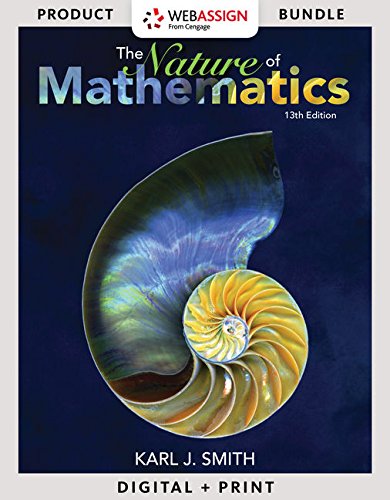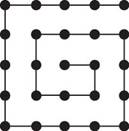
Bundle: Nature Of Mathematics, Loose-leaf Version, 13th + Webassign Printed Access Card For Smith's Nature Of Mathematics, 13th Edition, Single-term
13th Edition
ISBN: 9781337605076
Author: karl J. smith
Publisher: Cengage Learning
expand_more
expand_more
format_list_bulleted
Question
Chapter 9.2, Problem 12PS
To determine
Whether the given graph is tree or not.

Expert Solution & Answer
Want to see the full answer?
Check out a sample textbook solution
Students have asked these similar questions
=
2.035
765 03
-9 ws 64
7 sin &3-9sin 04 = 1.134
The diagram below models the layout at a carnival where G, R, P, C, B, and E are various locations on the grounds. GRPC is a parallelogram.
19
G
R
375 ft
425 ft
325 ft
B 225 ft
P
E
Part A: Identify a pair of similar triangles. (2 points)
Part B: Explain how you know the triangles from Part A are similar. (4 points)
Part C: Find the distance from B to E and from P to E. Show your work. (4 points)
Solve for theta 3 and 4
Chapter 9 Solutions
Bundle: Nature Of Mathematics, Loose-leaf Version, 13th + Webassign Printed Access Card For Smith's Nature Of Mathematics, 13th Edition, Single-term
Ch. 9.1 - Level 1 IN YOUR OWN WORDS Describe the Konigsberg...Ch. 9.1 - Prob. 2PSCh. 9.1 - Level 1 IN YOUR OWN WORDS Describe the solution to...Ch. 9.1 - Prob. 4PSCh. 9.1 - Prob. 5PSCh. 9.1 - Prob. 6PSCh. 9.1 - Prob. 7PSCh. 9.1 - Prob. 8PSCh. 9.1 - Prob. 9PSCh. 9.1 - Prob. 10PS
Ch. 9.1 - Which of the networks in Problem 6-11 have Euler...Ch. 9.1 - Prob. 12PSCh. 9.1 - Prob. 13PSCh. 9.1 - Prob. 14PSCh. 9.1 - Prob. 15PSCh. 9.1 - Prob. 16PSCh. 9.1 - Prob. 17PSCh. 9.1 - Prob. 18PSCh. 9.1 - Prob. 19PSCh. 9.1 - Prob. 20PSCh. 9.1 - Prob. 21PSCh. 9.1 - Prob. 22PSCh. 9.1 - Prob. 23PSCh. 9.1 - Prob. 24PSCh. 9.1 - Prob. 25PSCh. 9.1 - Prob. 26PSCh. 9.1 - Prob. 27PSCh. 9.1 - Prob. 28PSCh. 9.1 - Prob. 29PSCh. 9.1 - Prob. 30PSCh. 9.1 - Prob. 31PSCh. 9.1 - Prob. 32PSCh. 9.1 - HISTORICAL QUEST Travelers Dodecahedron This...Ch. 9.1 - HISTORICAL QUEST Is there an Euler circuit for the...Ch. 9.1 - Prob. 35PSCh. 9.1 - Prob. 36PSCh. 9.1 - Prob. 37PSCh. 9.1 - Prob. 38PSCh. 9.1 - Prob. 39PSCh. 9.1 - Prob. 40PSCh. 9.1 - The edges of a cube form a three-dimensional...Ch. 9.1 - A saleswoman wants to visit eastern cities, New...Ch. 9.1 - Prob. 43PSCh. 9.1 - Prob. 44PSCh. 9.1 - Repeat Problem 44 using the brute-force method....Ch. 9.1 - Count the number of vertices, edges arcs, and...Ch. 9.1 - The saleswoman in Problem 42 needs to add Atlanta...Ch. 9.1 - A quality control inspector must visit franchises...Ch. 9.1 - Prob. 49PSCh. 9.1 - Prob. 50PSCh. 9.1 - On a planet far, far away, Luke finds himself in a...Ch. 9.1 - How many paths are there to room n in Problem 51?...Ch. 9.1 - Emil Torday told the story of seeing some African...Ch. 9.1 - Prob. 54PSCh. 9.1 - Prob. 55PSCh. 9.1 - Prob. 56PSCh. 9.1 - Prob. 57PSCh. 9.1 - Prob. 58PSCh. 9.1 - Prob. 59PSCh. 9.1 - Prob. 60PSCh. 9.2 - Prob. 1PSCh. 9.2 - Prob. 2PSCh. 9.2 - Prob. 3PSCh. 9.2 - Prob. 4PSCh. 9.2 - Prob. 5PSCh. 9.2 - Prob. 6PSCh. 9.2 - Prob. 7PSCh. 9.2 - Prob. 8PSCh. 9.2 - Prob. 9PSCh. 9.2 - Prob. 10PSCh. 9.2 - Prob. 11PSCh. 9.2 - Prob. 12PSCh. 9.2 - Prob. 13PSCh. 9.2 - Prob. 14PSCh. 9.2 - Prob. 15PSCh. 9.2 - Prob. 16PSCh. 9.2 - Prob. 17PSCh. 9.2 - Prob. 18PSCh. 9.2 - Prob. 19PSCh. 9.2 - Prob. 20PSCh. 9.2 - Prob. 21PSCh. 9.2 - Prob. 22PSCh. 9.2 - Prob. 23PSCh. 9.2 - Prob. 24PSCh. 9.2 - Prob. 25PSCh. 9.2 - Prob. 26PSCh. 9.2 - Prob. 27PSCh. 9.2 - Prob. 28PSCh. 9.2 - Prob. 29PSCh. 9.2 - Prob. 30PSCh. 9.2 - Prob. 31PSCh. 9.2 - Prob. 32PSCh. 9.2 - Prob. 33PSCh. 9.2 - Prob. 34PSCh. 9.2 - Prob. 35PSCh. 9.2 - Prob. 36PSCh. 9.2 - Prob. 37PSCh. 9.2 - Prob. 38PSCh. 9.2 - Prob. 39PSCh. 9.2 - Prob. 40PSCh. 9.2 - Prob. 41PSCh. 9.2 - Prob. 42PSCh. 9.2 - Prob. 43PSCh. 9.2 - Prob. 44PSCh. 9.2 - Prob. 45PSCh. 9.2 - Prob. 46PSCh. 9.2 - Prob. 47PSCh. 9.2 - Prob. 48PSCh. 9.2 - Prob. 49PSCh. 9.2 - Suppose you wish to install a drip sprinkler...Ch. 9.2 - Prob. 51PSCh. 9.2 - Prob. 52PSCh. 9.2 - Prob. 53PSCh. 9.2 - Prob. 54PSCh. 9.2 - Prob. 55PSCh. 9.2 - Prob. 56PSCh. 9.2 - Prob. 57PSCh. 9.2 - Prob. 58PSCh. 9.2 - Prob. 59PSCh. 9.2 - Prob. 60PSCh. 9.3 - Prob. 1PSCh. 9.3 - Prob. 2PSCh. 9.3 - Prob. 3PSCh. 9.3 - IN YOUR OWN WORDS What is a tessellation?Ch. 9.3 - Prob. 5PSCh. 9.3 - Prob. 6PSCh. 9.3 - Prob. 7PSCh. 9.3 - Prob. 8PSCh. 9.3 - Prob. 9PSCh. 9.3 - Prob. 10PSCh. 9.3 - Prob. 11PSCh. 9.3 - Prob. 12PSCh. 9.3 - Prob. 13PSCh. 9.3 - Prob. 14PSCh. 9.3 - Prob. 15PSCh. 9.3 - Prob. 16PSCh. 9.3 - Prob. 17PSCh. 9.3 - Prob. 18PSCh. 9.3 - Prob. 19PSCh. 9.3 - Prob. 20PSCh. 9.3 - Prob. 21PSCh. 9.3 - Prob. 22PSCh. 9.3 - Prob. 23PSCh. 9.3 - Prob. 24PSCh. 9.3 - Prob. 25PSCh. 9.3 - Prob. 26PSCh. 9.3 - Prob. 27PSCh. 9.3 - Prob. 28PSCh. 9.3 - Prob. 29PSCh. 9.3 - Group the letters of the alphabet in the fonts...Ch. 9.3 - Prob. 31PSCh. 9.3 - Prob. 32PSCh. 9.3 - Prob. 33PSCh. 9.3 - Prob. 34PSCh. 9.3 - Prob. 35PSCh. 9.3 - Prob. 36PSCh. 9.3 - Prob. 37PSCh. 9.3 - Prob. 38PSCh. 9.3 - Prob. 39PSCh. 9.3 - Prob. 40PSCh. 9.3 - Prob. 41PSCh. 9.3 - Prob. 42PSCh. 9.3 - Prob. 43PSCh. 9.3 - Prob. 44PSCh. 9.3 - Prob. 45PSCh. 9.3 - Prob. 46PSCh. 9.3 - Prob. 47PSCh. 9.3 - Prob. 48PSCh. 9.3 - Prob. 49PSCh. 9.3 - Prob. 50PSCh. 9.3 - Prob. 51PSCh. 9.3 - Prob. 52PSCh. 9.3 - Prob. 53PSCh. 9.3 - Prob. 54PSCh. 9.3 - Prob. 55PSCh. 9.3 - Prob. 56PSCh. 9.3 - Prob. 57PSCh. 9.3 - Prob. 58PSCh. 9.3 - Prob. 59PSCh. 9.3 - Prob. 60PSCh. 9.CR - Prob. 1CRCh. 9.CR - Prob. 2CRCh. 9.CR - Prob. 3CRCh. 9.CR - Prob. 4CRCh. 9.CR - Prob. 5CRCh. 9.CR - Prob. 6CRCh. 9.CR - Prob. 7CRCh. 9.CR - Prob. 8CRCh. 9.CR - Prob. 9CRCh. 9.CR - Prob. 10CRCh. 9.CR - Prob. 11CRCh. 9.CR - Prob. 12CRCh. 9.CR - Prob. 13CRCh. 9.CR - Prob. 14CRCh. 9.CR - Prob. 15CRCh. 9.CR - Prob. 16CRCh. 9.CR - Prob. 17CRCh. 9.CR - Prob. 18CRCh. 9.CR - Prob. 19CRCh. 9.CR - Prob. 20CR
Knowledge Booster
Similar questions
- Given lim x-4 f (x) = 1,limx-49 (x) = 10, and lim→-4 h (x) = -7 use the limit properties to find lim→-4 1 [2h (x) — h(x) + 7 f(x)] : - h(x)+7f(x) 3 O DNEarrow_forwardWrite out and explain your steps for each of the problems.arrow_forward17. Suppose we know that the graph below is the graph of a solution to dy/dt = f(t). (a) How much of the slope field can you sketch from this information? [Hint: Note that the differential equation depends only on t.] (b) What can you say about the solu- tion with y(0) = 2? (For example, can you sketch the graph of this so- lution?) y(0) = 1 y ANarrow_forward
- Write out and explain your steps to each of these problems.arrow_forwardCalculate the area and perimeterarrow_forward65% of all violent felons in the prison system are repeat offenders. If 43 violent felons are randomly selected, find the probability that a. Exactly 28 of them are repeat offenders. b. At most 28 of them are repeat offenders. c. At least 28 of them are repeat offenders. d. Between 22 and 26 (including 22 and 26) of them are repeat offenders.arrow_forward
- (b) Find the (instantaneous) rate of change of y at x = 5. In the previous part, we found the average rate of change for several intervals of decreasing size starting at x = 5. The instantaneous rate of change of fat x = 5 is the limit of the average rate of change over the interval [x, x + h] as h approaches 0. This is given by the derivative in the following limit. lim h→0 - f(x + h) − f(x) h The first step to find this limit is to compute f(x + h). Recall that this means replacing the input variable x with the expression x + h in the rule defining f. f(x + h) = (x + h)² - 5(x+ h) = 2xh+h2_ x² + 2xh + h² 5✔ - 5 )x - 5h Step 4 - The second step for finding the derivative of fat x is to find the difference f(x + h) − f(x). - f(x + h) f(x) = = (x² x² + 2xh + h² - ])- = 2x + h² - 5h ])x-5h) - (x² - 5x) = ]) (2x + h - 5) Macbook Proarrow_forwardEvaluate the integral using integration by parts. Sx² cos (9x) dxarrow_forwardLet f be defined as follows. y = f(x) = x² - 5x (a) Find the average rate of change of y with respect to x in the following intervals. from x = 4 to x = 5 from x = 4 to x = 4.5 from x = 4 to x = 4.1 (b) Find the (instantaneous) rate of change of y at x = 4. Need Help? Read It Master Itarrow_forward
- Determine whether the inverse of f(x)=x^4+2 is a function. Then, find the inverse.arrow_forwardVelocity of a Ball Thrown into the Air The position function of an object moving along a straight line is given by s = f(t). The average velocity of the object over the time interval [a, b] is the average rate of change of f over [a, b]; its (instantaneous) velocity at t = a is the rate of change of f at a. A ball is thrown straight up with an initial velocity of 128 ft/sec, so that its height (in feet) after t sec is given by s = f(t) = 128t - 16t². (a) What is the average velocity of the ball over the following time intervals? [3,4] [3, 3.5] [3, 3.1] ft/sec ft/sec ft/sec (b) What is the instantaneous velocity at time t = 3? ft/sec (c) What is the instantaneous velocity at time t = 7? ft/sec Is the ball rising or falling at this time? O rising falling (d) When will the ball hit the ground? t = sec Need Help? Read It Watch Itarrow_forwardpractice problem please help!arrow_forward
arrow_back_ios
SEE MORE QUESTIONS
arrow_forward_ios
Recommended textbooks for you
 College Algebra (MindTap Course List)AlgebraISBN:9781305652231Author:R. David Gustafson, Jeff HughesPublisher:Cengage Learning
College Algebra (MindTap Course List)AlgebraISBN:9781305652231Author:R. David Gustafson, Jeff HughesPublisher:Cengage Learning

College Algebra (MindTap Course List)
Algebra
ISBN:9781305652231
Author:R. David Gustafson, Jeff Hughes
Publisher:Cengage Learning